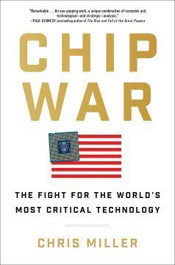Chip War: The Fight for the World’s Most Critical Technology

This is a clear, well-written, comprehensive history of the microchip industry, from its start in the 1940s all the way through to today.
First, it’s important to realize that the book (and the world, really) uses a bunch of words to refer to the same thing:
- Semiconductor
- Transistor
- Microchip
- Chip
- Integrated Circuit
- Silicon
Technically these are all different. But, colloquially, they refer to the same thing: the bits inside a computer that allow it to do math. Doing math means you can perform logic, and that’s what makes a computer work (if you want to go deep on this, see Code: The Hidden Language of Computer Hardware and Software).
The book follows the industry from the invention of the transistor, the creation of Silicon Valley, the formation of giants like Intel and Fairchild Semiconductor, and the creation of perhaps the weirdest supply chain and manufacturing process in the world.
The fact that we can manufacture (“fabricate,” in the industry parlance) chips at all is a perversion of physics. Essentially, the circuit designs are “reverse projected” onto the chip. When you “project” something (onto a wall, for instance), you take a small thing and make it bigger. To manufacture chips, you do the reverse – you take a big design, and project it into tiny, tiny form onto the chip surface, then it’s kind of “burned in” (not really, but it’s complicated).
The scale is absurd. There are literally billions and billions of little “logic units” on the surface of a chip. Getting these units imprinted on a chip requires a weird kind of light that is created by – hang on to something – shooting tin with a laser, twice, then capturing the light that comes off the resulting plasma, and doing this 50,000 times per second.
(In reading this, I kept thinking, “Maybe we weren’t meant to create these things, in a cosmological sense? Is God pissed at us for doing this?”)
The resulting supply chain is wild:
- Only three companies make the software you need to design chips (oddly: one of them used to be my client, but I didn’t understand what they did at the time; I visited their office in Mountain View once)
- A handful of other companies design the chips (using that software)
- Most of those companies can’t build the chips they design (they are “fab-less”; lacking fabrication capabilities)
- The number of actual fabricators is very small, depending on how advanced the chip is (how tiny the little logic units get; the gold standard right now is seven nanometers)
- There are only three fabricators that can make the most advanced chips
- All of these use a machine made by one company
- That machine requires a laser which is also made by one company (which was later acquired to protect the supply chain)
- The company at the heart of this – that makes 92% of the most advanced chips that the world needs – is located in Taiwan, and is therefore constantly under threat of being invaded by China
From an operations perspective, this is insane. The fact that we create billions of these chips a year seems like a massive coincidence.
And understand that these aren’t some esoteric product that only a few people need. Microchips are in everything. They’re in your toaster, right now. Without microchips, the world as we know it stops working.
The political implications are significant. China wants Taiwan back, but it won’t invade, largely because it can’t disrupt the microchip supply chain. It needs the chips that Taiwan makes. The rest of the world is careful about what we sell China. We want to sell them enough to keep them addicted, just enough so that they don’t do anything stupid.
Now consider that Joe Biden passed The Chip Act, which provided funding for chip fabricators to build factories in the continental United States. He did this to protect the microchip supply chain, and this has serious implications for Taiwan. If Taiwan isn’t needed to make the most advanced chips…then what? Can China invade now? If they do, what will the U.S. do about it?
Consider: a third world war could be indirectly based on where the next microchip factory is built. Some construction workers pouring concrete in Austin could unknowingly be kicking an apocalyptic snowball off a hill.
The title of the book is apt: there’s a huge, quiet war around the microchip supply chain. Humanity has gotten addicted to a thing that is very hard to make. We are beholden to this object and all the machinations that allow it to be produced.
Consequently, the book is way, way scarier than a business history book should be.
Book Info
- I have read this book. According to my records, I completed it on .
- I own an electronic copy of this book.